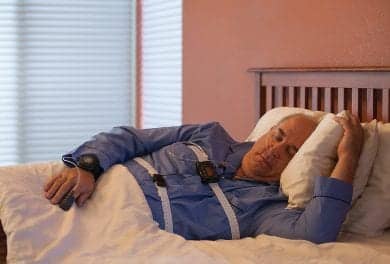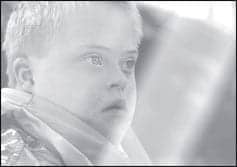Advances in home sleep testing may chip away at the number of people who remain undiagnosed while capturing a more accurate calculation of the apnea hypopnea index.
By Jane Kollmer
There are many barriers that prevent patients from receiving an accurate diagnosis of sleep apnea, says Amir Reuveny, PhD, CEO and co-founder of Wesper, maker of a wireless patch-based home sleep test. One reason is that patients may find the diagnostic gold standard of in-lab polysomnography (PSG) cumbersome, inaccessible, and expensive.
While it is impossible to know the full scope of the problem, some estimates suggest that more than 80% of people with moderate to severe sleep apnea remain undiagnosed.1 What’s more, there is the population whose sleep apnea is underdiagnosed, which includes patients who have symptoms and get a sleep study done, but they are diagnosed as either not having sleep apnea or having a milder form of it than they actually have.
“The number of people with undiagnosed sleep apnea is really staggering,” Reuveny says. “The disorder leads to a very critical deterioration of health and links to many serious chronic conditions such as cardiovascular disease and diabetes.”
Thankfully, the latest advances in home sleep testing (HST) help address the issues contributing to both un- and under-diagnosis of sleep apnea. Newer technologies that measure sleep time (not only recording time), small devices that increase comfort and accessibility, multi-night recording capabilities, and wireless devices all have advanced the art and science of accurately diagnosing a person’s sleep apnea severity.
Luciana Rabello de Oliveira, clinical director of ResMed, says, “Some benefits of home sleep tests are greater accessibility to testing for people who are unable or unwilling to stay at an overnight clinic, high clinical accuracy of some HSATs [home sleep apnea tests] for diagnosing obstructive sleep apnea, and cloud connectivity with certain HSATs that enable patients’ doctors to quickly see their results, reducing the time it takes to get people with sleep apnea the therapy solution they need.”
Reaching the Undiagnosed Population
Some patients who would not consider an in-lab sleep study are open to home testing due to its comfort and convenience.
Sveinbjörn Höskuldsson, chief technology officer of Nox Medical, maker of both in-lab and home sleep study equipment, says, “If you want to get an accurate measure of normal sleep, you would like the patient to sleep in a normal environment and that is in their own bed.”
In designing home sleep testing devices, he says Nox has the mantra: “It needs to be more complete, but less complex.” In other words, simplicity is essential to making the test easy for the user, but for the results to be meaningful, the output needs to contain a comprehensive, reliable set of data that the physician can use to make an accurate diagnosis.
“We need to make some compromises to be able to do [sleep studies] at home, compared with the elegant studies we can do in hospitals. But we can’t drop the quality of the studies because we don’t want to misdiagnose people and we don’t want to deploy technology that does not work for the patient population that we’re trying to cover,” Höskuldsson says. “We really need to get to the point where we can deploy technology that is accessible to everyone and still provides high-quality results.”
What About Underdiagnosis?
Home sleep tests have come a long way in their ability to detect even the subtlest breathing inconsistencies that can affect sleep, leading to more reliable test results. The latest class of devices are more sophisticated than they were in the past—and they continue to improve.
“Home sleep apnea tests have traditionally under-detected sleep apnea and underestimated its severity due to the fact that they lack means for distinguishing sleep from wakefulness and for detecting microarousals from sleep,” says sleep physician Alan R. Schwartz, MD, a trainer with Zoll Itamar’s PAT Academy. “HSAT devices that distinguish sleep from wakefulness, determine the stage of sleep, and detect microarousals hold a major advantage over others that do not, simply because they offer greater accuracy in diagnosing the presence and severity of sleep apnea.”
Bogi Palsson, CEO of SleepImage, marketer of a ring-based home sleep testing device, says, “In order to get the full picture of sleep, you need to be able to measure both sleep versus wake and respiration during sleep.” The SleepImage System creates a profile based on coupling the heart rate variability and respiration data collected during sleep. “These signals are both highly influenced by the autonomic nervous system,” he says.
Underdiagnosis could also occur in patients who had a better night of sleep than usual during the overnight study. Evidence suggests that sleep apnea varies in its severity from one night to the next.2 As a result, a single-night study may return results that characterize the presence and severity of sleep apnea less precisely. Some physicians use multi-night recordings—which most new devices are capable of facilitating—as a solution for misdiagnosis or underdiagnosis of sleep apnea due to limited data.
Wesper’s solution includes a sleep health platform that allows users to quantify their breathing, pulse, body positions, snoring. The sleep data is then analyzed in sync with lifestyle and other health information. The two patches worn on the skin measure more than 10 different channels and feed the data to the physician. Reuveny says, “We believe that combining medical-grade level results with longitudinal data over time and an expert’s support will give the user the best chance to help them realize what’s really going on with their sleep and take action to improve it.”
Expect more innovation to come. For instance, Nox Medical has developed “BodySleep”—cleared for use in Europe but not yet in the United States–which uses an artificial intelligence algorithm to analyze respiratory and actigraphy signals. Höskuldsson says, “The home testing systems are proven to be quite accurate and they’re getting more accurate because artificial intelligence can be used to increase the processing of the data being collected, thus getting a better estimation of the sleep time.”
Why It Matters
As treatment decisions are based in part on the severity of sleep apnea, a precise diagnosis is important. At times, patients with mild sleep apnea can be treated with lifestyle measures (such as weight loss) and CPAP alternatives. In contrast, CPAP therapy remains first-line treatment for patients with moderate to severe sleep apnea, followed by other medical and surgical alternatives in CPAP-intolerant patients.
Undiagnosis and underdiagnosis can affect people of all ages, genders, body types, races, and backgrounds. So with new technology enticing the undiagnosed to get tested, the impact can be powerful. Rabello de Oliveira says, “The more we can educate people on the importance of sleep, help them recognize the signs of poor sleep, and encourage them to approach their doctors for guidance, screening, and testing as appropriate, the more often people can realize they have this prevalent and easily treatable disease.”
Jane Kollmer is co-owner of Ch/At Communications, which provides writing and editing services to clients in the healthcare and travel industries.
References
1. Young T, Evans L, Finn L, Palta M. Estimation of the clinically diagnosed proportion of sleep apnea syndrome in middle-aged men and women. Sleep. 1997 Sep;20(9):705-6.
2. Punjabi NM, Patil S, Crainiceanu C, Aurora RN. Variability and misclassification of sleep apnea severity based on multi-night testing. Chest. 2020 Jul;158(1):365-73.
Illustration 100388432 © Hobbitfoot | Dreamstime.com




